Abstract
Introduction: Among the animals that cause accidents in children, dogs and cats, some wild animals are kept like “pet” or in exposition, synanthropic animals and farm animals. Objective: To characterize patients attended by emergency caused by these animals in at the National Health Institute of Children, during 1995-2009. Materials and Methods: Data was gathered from medical records including, general information from patients, animal aggressor and injuries. Results: 142 cases were registered. The 62.7% were up to 4 years, 26.8% from 4 to 9 years, and 10.6% over 9 years. The 48.6% were male and 51.4% were females. The 73.2% were treated as outpatients and 26.8% needed hospitalization. The 64.8% of accidents were caused by synanthropic animals, 21.8% by wild animals and 13.4% by farm animals. The anatomical areas mainly affected were upper limbs (54.9%), and face, head, and neck (40.1%). The 76.8% of accidents were of a kind and 23.2% were multiples. Superficial injuries were 69.7% and deep lesions were 30.3%. 78.2% of the accidents needed medical treatment and 21.8% surgical treatment. Only 28.2% of the cases received rabies vaccines. The 23.9% of the patients had aesthetic consequences (face) and 69.1% in the body, and the 7.0% both areas. Conclusions: Supervision from parents and educational programs are necessary to prevent and diminish the frequency of these accidents in the population.Downloads
Download data is not yet available.



